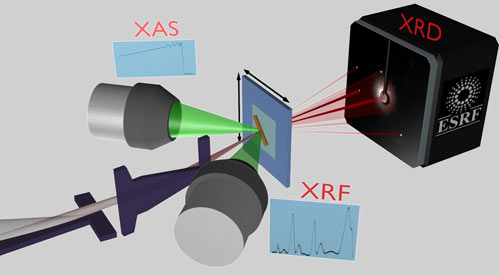Overview
Within the framework of the Upgrade Programme, the new state-of-the-art synchrotron beamline ID16B has been recently developed for hard X-ray nano-analysis and is dedicated to research areas with high scientific and societal impacts such as nanotechnology, earth and environmental sciences, and bio-medical research. Based on a canted undulator, this long beamline provides hard X-ray nanobeams optimized mainly for spectroscopic applications, including the combination of X-ray fluorescence, X-ray absorption spectroscopy, X-ray diffraction, X-ray Excited Optical Luminescence, X-ray Beam Induced Current, as well as nanotomography.

Techniques available:
- 2D/3D nano X-ray fluorescence (XRF)
- Nano X-ray absorption spectroscopy (nano-XAS)
- Nano-tomography
- 2D/3D nano X-ray diffraction (nano-XRD)
- Nano X-ray excited optical luminescence (nano-XEOL)
- Nano X-ray beam induced current (nano-XBIC)
Beam modes:
- Pink beam (from 17 to 33 keV): ∆E/E=10-2 , flux = 1011-1012ph/s
- Monochromatic beam (from 6 to 14 and 17 to 33 keV): ∆E/E=10-4 , flux = 1010-1011 ph/s
Energy range:
- Nano-XRF, nano-XAS, nano-XRD, nano-XEOL: from 6 to 33 keV
- Nano-tomography: 17 or 30 keV
Beam size:
- Pink or Monochromatic mode (from 17 to 33 keV): 50x50 nm2
- Monochromatic mode (from 6 to 14 keV): from 80 to 100 nm2
In-situ environments
- He cryostat for XEOL
- High Temperature furnace for in-situ nanotomography
- Specific devices developed by users



